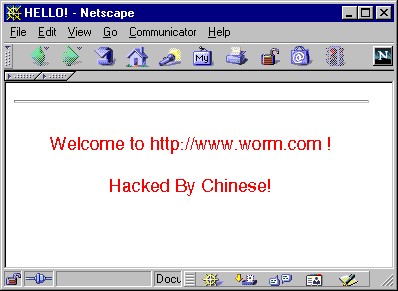Worm:W32/CodeRed
Summary
This is original Code Red web worm (the A variant) found originally in July 2001.
Removal
Microsoft has released a patch that addresses the vulnerability used by this worm. Apply the security patch for this vulnerability from:
Then reboot the server. Since the worm's code is not written to a hard disk (it exists only in memory) rebooting will eliminate the infection completely.
A False Positive is when a file is incorrectly detected as harmful, usually because its code or behavior resembles known harmful programs. A False Positive will usually be fixed in a subsequent database update without any action needed on your part. If you wish, you may also:
-
Check for the latest database updates
First check if your F-Secure security program is using the latest updates, then try scanning the file again.
-
Submit a sample
After checking, if you still believe the file is incorrectly detected, you can submit a sample of it for re-analysis.
Note: If the file was moved to quarantine, you need to collect the file from quarantine before you can submit it.
-
Exclude a file from further scanning
If you are certain that the file is safe and want to continue using it, you can exclude it from further scanning by the F-Secure security product.
Note: You need administrative rights to change the settings.
Technical Details
History
UPDATE ON 1ST OF AUGUST, 2001
By 15:00 GMT, 15 hours after widespread Code Red infections restarted, the situation is getting rapidly worse. The worm has gone worldwide again, infecting vulnerable web sites at an increasing rate. The number of infected servers almost doubles every hour, and has passed 20,000 infected machines. In comparison, on 19th of July, Code Red infected around 300,000 servers, and was only stopped because the worm stopped infections by itself. This time around the worm won't stop spreading for another three weeks.
UPDATE ON 1ST OF AUGUST, 2001
By 12:00 GMT, 12 hours after the new spreading phase for the Code Red worm restarted, no visible effects of the worm could be seen. The worm did restart spreading, as feared, but initial rate of infections was not very fast. The worm might gain more ground later on, but it's likely that the number of reinfected web servers will be lower than in July, and effects of the worm to general public will be minimal.
Propagation
Code Red is a worm that exploits a security hole in Microsoft Internet Information Server (IIS) to spread. When it infects a server it starts to scan for other vulnerable servers and infects them. During a certain period of time the worm only spreads, then it initiates a Denial-of-Service (DoS) attack against www1.whitehouse.gov and finally suspends all the activities.

This repeats every month. The time zone in the above picture is GMT. The worm can resume into infection phase at midnight July 31st, if there is infected servers in the Internet with incorrect date settings causing that they already are scanning for vulnerable hosts; or the worm is restarted manually by a malicious party. The front page of an infected server might have been changed by the worm to following:

)
Protect your devices from malware with F‑Secure Total
Protecting your devices from malicious software is essential for maintaining online security. F‑Secure Total makes this easy, helping you to secure your devices in a brilliantly simple way.
- Award-winning antivirus and malware protection
- Online browsing, banking, and shopping protection
- 24/7 online identity and data breach monitoring
- Unlimited VPN service to safeguard your privacy
- Password manager with private data protection
More Support
Community
Ask questions in our Community .
User Guides
Check the user guide for instructions.
Submit a Sample
Submit a file or URL for analysis.